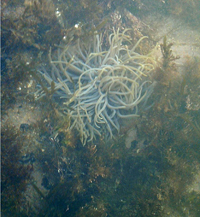Discovery of anaphylaxis

Anaphylaxis describes an organism becoming hypersensitive rather than being protected by its immune response. Richet studied dogs which he injected with a high dose of anemone toxin. After a few weeks, those which seemed healthy were used for a new experiment.
This time, the dogs developed serious and fatal toxic shock reactions in response to even the smallest injection of the toxin. Richet repeated these experiments and from them defined the features of anaphylaxis:
- Subjects were more sensitive than one that was new to the poison.
- The symptoms of the second injection (swift depression of the nervous system) did not resemble the symptoms of the first injection.
- There was an incubation period before anaphylaxis resulted.
Transferring blood from an anaphylactic animal to a healthy one produced anaphylaxis, showing the cause to be in the blood. The reaction occurred not only in response to known toxins, but to any protein, and occurred in all animals, though guinea pigs were particularly sensitive.
In humans anaphylaxis was a particular problem where serum therapy was used, and remains a problem today for treatments of animal stings and bites. Someone who receives a second dose of a given toxin within 10-30 days of the first has a 90% chance of anaphylactic shock.
Last edited: 5 November 2014 13:31
